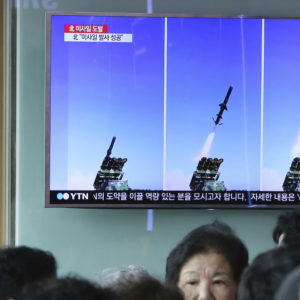The North Korean Dearest Leader — or whatever they’re calling the new one — can’t lob a nuke onto the U.S. mainland.
Yet.
But he can probably hit Alaska. Or will be able to, soon enough.
The North Korean people may be starving, but Kim Jong Un’s regime is pouring resources toward the development of long-range Intercontinental Ballistic Missiles (ICBMs) with a range sufficient to strike the U.S. mainland as well as Intermediate Range Ballistic Missiles (IRBMs) that could strike regional allies such as Japan and the U.S. base on Okinawa.
Some experts — including Riki Ellison, founder of the Missile Defense Advocacy Alliance outside Washington, believe that the North Korean regime already has operational missiles capable of striking the Aleutian Islands in Alaska.
The apparently successful test on July 4 by the North Koreans of an ICBM confirms this fear.
The country’s nuclear program, meanwhile, may have already developed nuclear devices with a yield in the 10-15 kiloton range, comparable to the bombs that leveled Hiroshima and Nagasaki at the close of World War II.
These devices probably haven’t been miniaturized yet sufficiently such that they could be mounted on a missile — and the long-range ICBMs needed to fly them to targets on the U.S. mainland may still be a work in progress.
But that work continues.
Meanwhile, what is being done to defend against this threat?
How about shipping the latest ground-based anti-missile defense system to … Eastern Europe? Romania and Poland, to be specific.
Yup.
Anti-ballistic missiles tested in Hawaii — at the Pacific Missile Range Facility — are being shipped to Europe for their operational deployment. Once again, American taxpayers are on the hook for defending Western Europe … at the expense of their own West Coast.
This was done while Barack Obama was president — alongside massive cuts in missile defense generally. Western Europe would be protected, Cold War-style, against a not-as-likely nuclear attack by Russia (Vladimir Putin is many things but he is not a Dr. Evil outfit-wearing loon, as the current North Korean Dearest Leader appears to be) while the West Coast of America would left, essentially, wide open.
In addition to cutting missile defense funding by more than 25 percent and moving missile defenses away from the most obvious threat areas, the former president also took a kind of stealth ax to the development of ground-based missile defense programs by imposing a bureaucratic mandate called “disaggregation,” which would have Pentagon bureaucrats micromanage the program at each level of the development and procurement process.
This was put into effect in the waning days of the Obama presidency as kind of last-minute attempt to impose the Obama administration’s priorities: more spending on entitlements — including the president’s signature entitlement, Obamacare — at the expense of national defense programs) ex post facto on the current administration.
Though touted as a way to reduce cost-overruns, “disaggregation” adds layers of bureaucracy to a process that had been more streamlined. And that invariably costs money. Which may have been the intended-but-unspoken purpose.
It’s harder to outright defund a program such as missile defense that most people — including politicians on both sides of the aisle — accept as a necessary expense. It’s easier to slowly strangle it with red tape and delays.
Meanwhile, the Dearest Leader continues to play with his newest toys.
The irony is that defending against this very real threat — as opposed to the lesser threat of Putin’s Russia — won’t cost a fortune or require a monster legislative sell.
With regard to defending regional allies such as South Korea and Japan — and Hawaii and Alaska — from the possibility of a North Korean missile attack, all that would be needed is to deploy/activate some of the already developed and already-paid-for Aegis missiles to defend the U.S. rather than ship them all to Eastern Europe.
Ellison, of the Missile Defense Advocacy Alliance, points out that “we have the crews, we have the missiles and we have the radar … the fact is we have capabilities that can be turned on and made fully operational in an emergency.”
A creepy low-rent Stalinist who has repeatedly threatened to launch a pre-emptive nuclear attack against the United States surely qualifies as just such an emergency.
And with regard to developing efficiently a full-spectrum ground-based missile defense shield that would protect both coasts of the U.S. mainland as well as deter regional Dr. Evils such as Kim Jong Un, all that’s necessary is for President Trump to countermand the last-minute “disaggregation” edict his lame-duck predecessor tossed out on his way out.
The former president had no mandate to lay his dead hand (so to speak) on the tiller of American defense policy as he was packing his bags and getting ready to hit the rubber-chicken speaker circuit.
President Trump, on the other hand, has exactly such a mandate — and his campaign slogan, “putting America first,” surely ought to apply to defending America first.

